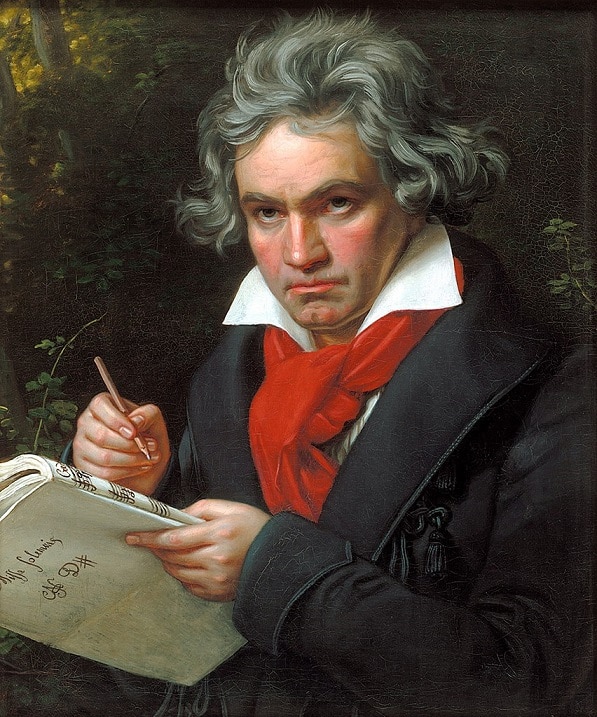
The following pieces are very much my personal choice of music from this great composer. There are many other astonishing pieces that Beethoven composed that I have not included here but perhaps will become part of another article another day.
Beethoven’s output was extensive with the only genre of music he did not devote significant time to being Opera. The instrumental music Beethoven composed consisted largely of Symphonies, Concertos, Chamber Music, and Overtures, and it is from these works that I have made my selection.
Read also:
The Best of Beethoven
1. Piano Concerto No. 4 in G Major: Op.58
This is one of the most extraordinary pieces that Beethoven composed in his brief lifetime. The G Major Piano Concerto is the fourth of five Piano Concertos that Beethoven completed. There exists a sketch for a sixth Piano Concerto in D Major but this was never finished.
Many people would agree that Beethoven developed the concerto as a musical form way beyond the conventions of the Classical period. This concerto is no exception. Instead of a lengthy exposition by the orchestra where we hear the musical ideas for the movement, Beethoven decides to allow the piano to speak first.
What we hear is a gentle, eight-note chord of G major followed by a series of chords that softly mark out the opening material of the whole piece. It’s wonderfully understated and almost hesitant. There is a pervading sense of calm with underlying strength.
The concerto was composed between 1805 and 1806 with its premiere in Vienna in 1808. This was not a good occasion for Beethoven who had programmed a very lengthy concert and had been granted insufficient time to rehearse. The concerto received a lukewarm reception much to Beethoven’s distress and received almost no attention until after the composer’s death.
The concerto comprises of three movements marked as follows:
- Allegro moderato
- Andante con moto
- Rondo, Vivace
2. Symphony No. 7 in A Major: Op.92 (The Pastoral)
Beethoven completed nine symphonies in his lifetime; the ninth or choral symphony probably being the best known for “Ode to Joy”. The Seventh Symphony (1812) for me is one of the most wonderful works that Beethoven composed. There is the familiar muscularity we come to expect in this symphony with a melodic and harmonic beauty that is almost unsurpassed in any other of his symphonic works.
There are four movements in the seventh symphony as follows:
- Poco sostenuto – Vivace
- Allegretto
- Presto – Assai memo presto
- Allegro con brio
Marches mix with lighter dance-like sections and we are aware of Beethoven stretching his compositional ideas into new forms and shapes. The choice of key is also significant here. A major is for Beethoven somewhat unusual as he regularly favored the darker, flatter keys that perhaps captured the essence of the composer more readily. A major by contrast is bright and brings a renewed feeling of hope. Richard Wagner described the symphony as “the apotheosis of the dance” which sheds a clear light onto the composition and gives a solid starting point with which to listen.
The slow movement, which is not a true slow movement at all, is far darker and at times funereal. It was this movement that brought the composer more success than the rest of his symphony.
3. Piano Sonata No.21 in C Major Op.53 (The Waldstein)
This middle-period Beethoven work has been described by some a heroic and symphonic. It consists of three lengthy movements as follows:
- Allegro con brio
- Introduzione: Adagio molto
- Rondo: Allegretto moderato – Prestissimo
The Waldstein Sonata was composed for Count Ferdinand von Waldstein, who was one of the first nobles to patronise the young Beethoven. I find this Sonata to be the one that like the seventh symphony finds Beethoven trying out all manner of new ideas, especially in terms of musical form.
The first and third movements form the substantial bulk of the musical material with the middle movement really acting more like an intermezzo or introduction to the finale than a fully-fledged movement in its own right.
The opening of the Waldstein is dramatic and inspiring with pounding quaver chords that drive a rhythmic thread through the entire movement. There is a tremendous feeling of momentum in this opening movement coupled with a sense of unease. Dramatic changes of dynamic, chromaticism, and Beethoven exploring the full range of the new piano.
Following the four minutes of the second movement that brings a momentary calm after the opening Beethoven leads us into the finale. This third movement is in rondo form and returns to the home key of C major.
The pulsing quavers have slowed but underpin the gentle melody that flows over the top. Before longs Beethoven allows the music to explode into a dazzling virtuosic display of emotion and technical skill.
Beethoven does not do what we might expect to conclude this huge sonata. Instead of what could have been a subtle, soft conclusion he pushes the opening rondo theme on into a rapid prestissimo conclusion. By the final chords, there is a huge feeling of triumph and success.
4. String Quartet in F Major Op.59, no.1
For this piece of chamber-music, we move backward in time to the year 1805. An amateur violinist and Russian ambassador by the name of Count Razumovsky
The first movement is in traditional Sonata form although significantly developed by Beethoven. It has a certain nobility about it and contains what is considered by many as one of the best of the themes composed by Beethoven. It is equally distinctive as it first appears in the cello, not the first violin as we might expect.
A scherzando follows in what initially appears to be a child-like manner but presents the rhythmic motives that create the movement. Texturally, the work is quite exposing for the players as each has an equal opportunity to work as a soloist as well as a quartet.
The slow movement finds Beethoven in a mournful mood. The tempo marking of Adagio e molto mesto (slowly and very sadly), clearly illustrates the composer’s gloomier thoughts. What we do know is that Beethoven’s brother had married a woman he could not abide and this hatred and sense of isolation permeate the third movement of the quartet. There is no ending to the third movement that passes into the finale that is based, as the Count requested, on a Russian theme. The mood is lifted and Beethoven continues into a more joyful uplifting final movement.
